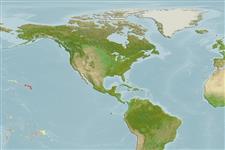Classification / Names
Common names | Synonyms | Catalog of Fishes (gen., sp.) | ITIS | CoL | WoRMS | Cloffa
Actinopterygii (ray-finned fishes) >
Perciformes (Perch-likes) >
Gobiidae (Gobies) > Gobionellinae
Etymology: Gnatholepis: Greek, gnathos = jaw + Greek,lepis = scale (Ref. 45335); knighti: Named for Knight Starr Jordan, the son of David Starr Jordan (Ref. 54834). More on author: Jordan, Evermann.
Environment / Climate / Range
Ecology
Marine; pelagic-neritic; depth range 0 - 5 m (Ref. 92171). Tropical, preferred ?
Distribution
Countries | FAO areas | Ecosystems | Occurrences | Point map | Introductions | Faunafri
Western Central Pacific: Known only from the Hawaiian island chain.
Size / Weight / Age
Maturity: Lm ? range ? - ? cm
Max length : 6.4 cm SL male/unsexed; (Ref. 92171); 6.1 cm SL (female)
Short description
Morphology | Morphometrics
Dorsal
spines
(total): 7 - 8;
Dorsal
soft rays
(total): 10-12;
Anal
spines: 1;
Anal
soft rays: 10 - 11. This large stocky Gnatholepis species (up to 64 mm SL) is distinguished by the following characters: cycloid scales on predorsal region, cheek and pectoral fin base; a distinct flap present at end of lower lip; 3 or more dark spots along first spine of first and second dorsal fins, followed by at least 3 rows of dark spots or short streaks; pectoral fin plain translucent to pale brownish; transverse black line crossing upper part of eye usually split in 2; anal fin plain dusky, often with one to several blackish rounded to oval spots posteriorly, or with dark streaks following membrane; D2 and A nearly always I,11; pectoral rays 15-17 (usually 16); lateral scales 25-29 (usually 27); predorsal scales 7-10 (usually 8-9) (Ref. 92171).
Most specimens have been collected from shallow habitats, tide pools or 'brackish pools', at depths of 0-5 m, from sand and mangrove areas (Ref. 92171).
Life cycle and mating behavior
Maturity | Reproduction | Spawning | Eggs | Fecundity | Larvae
Larson, H.K. and D.J. Buckle, 2012. A revision of the goby genus Gnatholepis Bleeker (Teleostei, Gobiidae, Gobionellinae), with description of a new species. Zootaxa 3529:1-69. (Ref. 92171)
IUCN Red List Status (Ref. 115185)
CITES (Ref. 94142)
Not Evaluated
Threat to humans
Harmless
Human uses
More information
CountriesFAO areasEcosystemsOccurrencesIntroductionsStocksEcologyDietFood itemsFood consumptionRation
Common namesSynonymsMetabolismPredatorsEcotoxicologyReproductionMaturitySpawningFecundityEggsEgg development
Age/SizeGrowthLength-weightLength-lengthLength-frequenciesMorphometricsMorphologyLarvaeLarval dynamicsRecruitmentAbundance
ReferencesAquacultureAquaculture profileStrainsGeneticsAllele frequenciesHeritabilityDiseasesProcessingMass conversion
Tools
Special reports
Download XML
Internet sources
Estimates of some properties based on models
Phylogenetic diversity index (Ref.
82805): PD
50 = 0.5010 [Uniqueness, from 0.5 = low to 2.0 = high].
Bayesian length-weight: a=0.00871 (0.00395 - 0.01919), b=3.05 (2.86 - 3.24), in cm Total Length, based on LWR estimates for this (Sub)family-body shape (Ref.
93245).
Trophic Level (Ref.
69278): 3.3 ±0.4 se; Based on size and trophs of closest relatives
Resilience (Ref.
69278): High, minimum population doubling time less than 15 months ().
Vulnerability (Ref.
59153): Low vulnerability (17 of 100) .
